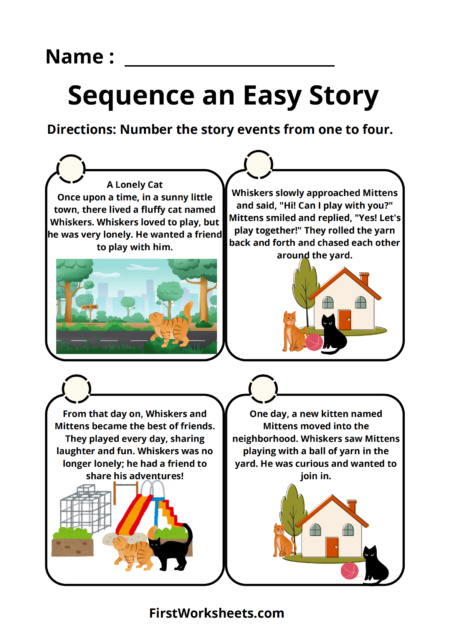2nd Grade Reading Worksheets
2nd-grade reading worksheets are designed to help students build foundational literacy skills, develop comprehension abilities, and increase vocabulary knowledge. Here’s an in-depth look at the core elements these worksheets often cover and their educational value:
Reading Comprehension
- Purpose: Comprehension worksheets focus on helping students understand what they read, not just read the words. This skill is crucial as it lays the groundwork for more complex reading and analysis in later grades.
- Activities Included:
- Short Stories or Passages: Students read a short text and answer questions to test their understanding. These stories usually revolve around relatable topics or simple fictional plots.
- Multiple Choice and Short Answer Questions: After reading, students might answer questions related to the main idea, key details, character actions, or events.
- Sequencing: Worksheets may ask students to put events in order, which helps in understanding narrative flow.
- Cause and Effect: Students identify what happens in a story and why, which promotes logical thinking and helps them recognize story structures.
Vocabulary Building
- Purpose: Developing a strong vocabulary is essential for reading fluency and comprehension, especially as texts become more complex in higher grades.
- Activities Included:
- Sight Words Practice: Worksheets often include sight words, which are common words that don’t always follow standard phonetic rules. Mastering these words helps improve reading fluency.
- Context Clues: Vocabulary worksheets encourage students to understand new words by analyzing the surrounding text, a skill critical for independent reading.
- Synonyms and Antonyms: Simple exercises introduce synonyms and antonyms, allowing students to explore language variety and nuance.
Phonics and Decoding Skills
- Purpose: Phonics worksheets support students in understanding the relationship between letters and sounds, a foundational skill for reading accuracy and fluency.
- Activities Included:
- Consonant Blends and Digraphs: Worksheets often focus on common blends (like “bl,” “cl,” “tr”) and digraphs (like “sh,” “ch,” “th”) to help students read multi-syllabic words.
- Vowel Sounds: Second grade introduces long and short vowel sounds, helping students recognize patterns and sound out new words.
- Silent Letters and Word Endings: Worksheets may cover words with silent letters (like “kn” in “know”) or various endings (“-ed,” “-ing”), allowing students to decode and pronounce words accurately.
Grammar and Sentence Structure
- Purpose: Understanding sentence structure helps students with both reading fluency and writing clarity, teaching them how sentences are formed and how meaning is conveyed.
- Activities Included:
- Identifying Parts of Speech: Worksheets often include exercises on nouns, verbs, adjectives, and simple pronouns, allowing students to see how words function within sentences.
- Sentence Correction: Activities might involve spotting and correcting simple grammar errors, which reinforces their understanding of proper sentence construction.
- Constructing Sentences: Students may be asked to form their own sentences using prompts, helping them apply grammar skills practically.
Story Elements and Literary Skills
- Purpose: Introducing basic literary elements at an early stage helps children recognize these elements in more complex texts as they progress in school.
- Activities Included:
- Identifying Main Idea and Details: Students learn to pinpoint the central theme of a story and identify supporting details.
- Character, Setting, and Plot Analysis: Worksheets may ask students to describe the characters, setting, and main events in a story, building their ability to analyze texts.
- Making Predictions: Some worksheets encourage students to guess what might happen next, fostering critical thinking and engagement with the story.
Critical Thinking and Inference Skills
- Purpose: Inferencing teaches students to “read between the lines” and draw conclusions beyond the explicit text, a crucial skill for advanced comprehension.
- Activities Included:
- Picture-Based Inferences: Worksheets may include images where students use clues in the picture to infer what is happening.
- Text-Based Inferences: Simple texts encourage students to make educated guesses based on given information, an essential skill for comprehension.
Reading Fluency and Expression
- Purpose: Fluency exercises help students read more naturally and with the correct intonation, making reading smoother and more enjoyable.
- Activities Included:
- Repeated Reading Practice: Some worksheets encourage students to read passages multiple times to increase their reading speed and accuracy.
- Reading Aloud with Expression: Worksheets might include guidance for reading aloud with emotional expression, such as paying attention to punctuation and tone.
By incorporating these worksheets into regular study routines, educators and parents can support students in becoming skilled, enthusiastic readers with a solid grasp of early literacy essentials.
